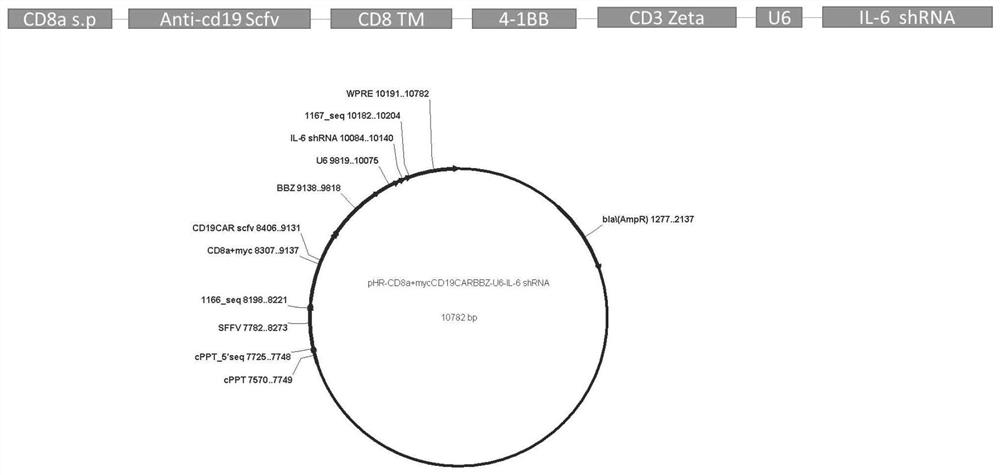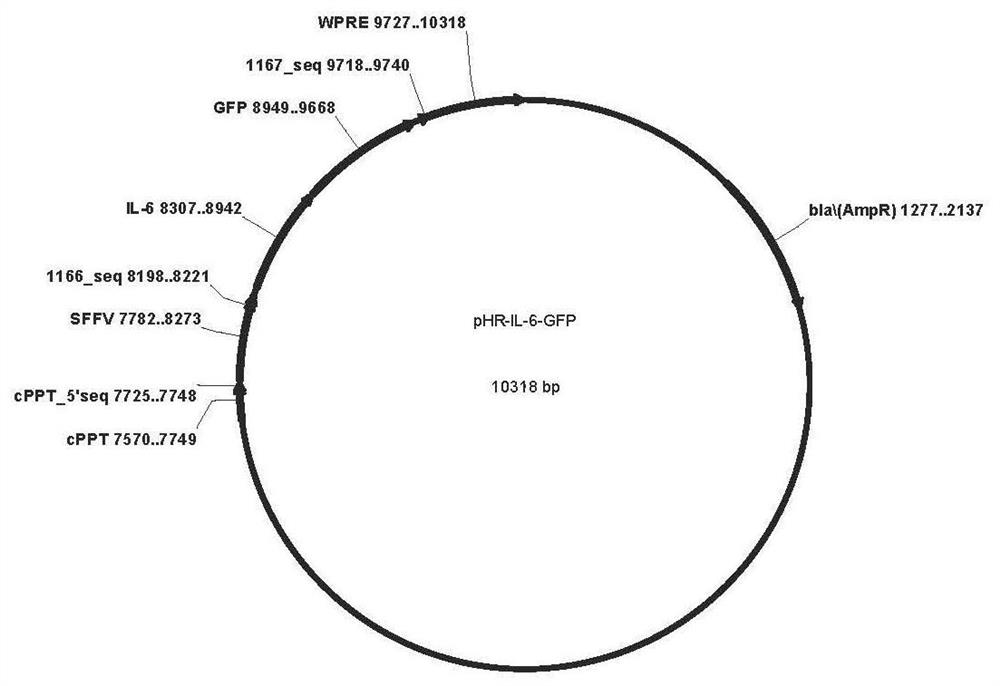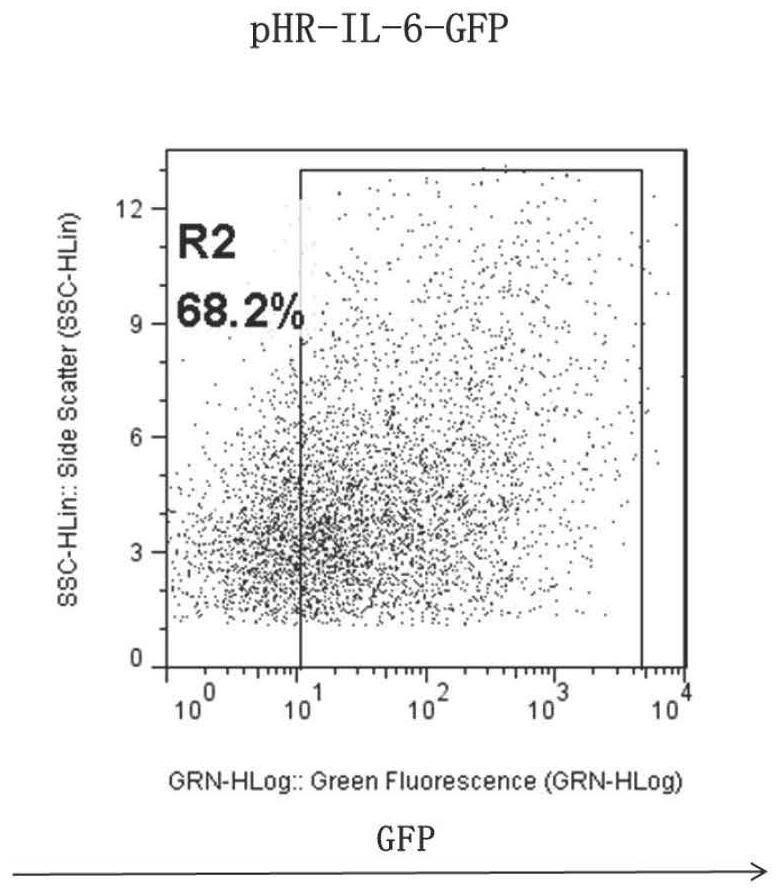CD19-car-t cell interfering with il-6 expression and its application
An IL-6, il-6shRNA-1 technology, applied in the fields of genetic engineering and cell biology, can solve the problems of short duration of interference, death of patients, and interference of target gene expression, etc.
- Summary
- Abstract
- Description
- Claims
- Application Information
AI Technical Summary
Problems solved by technology
Method used
Image
Examples
Embodiment 1
[0094] Example 1: Synthesis of IL-6 shRNA capable of being cloned into a vector
[0095] Check the sequence of IL-6 shRNA on the official website of Sigma-Aldrich China, and select three of them (6-1, 6-2, 6-3), and their nucleotide sequences are shown below.
[0096] 6-1: CCGG CTGGATTCAATGAGGAGACTT CTCGAGAAGTCTCCTCATTGAATCCAGTTTTTG.
[0097] 6-2: CCGG CAGAACGAATTGACAAACAAA CTCGAGTTTGTTTGTCAATTCGTTCTGTTTTTG.
[0098] 6-3: CCGG ATGAGCGTTAGGACACTATTT CTCGAGAAATAGTGTCCTAACGCTCATTTTTTG.
[0099] Wherein, the underlined sequence is the sequence of siRNA in each.
[0100] The present invention adopts the traditional method of cloning into vector, and inserts two DNA oligonucleotides encoding IL-6 siRNA sequence into the vector. The DNA oligonucleotide is a positive-sense siRNA sequence containing 21 nucleotides long, and the 9-nucleotide spacer sequence TTCAAGAGA successfully used by Ambion scientists is connected to its reverse complementary antisense siRNA sequence. 5 Ts...
Embodiment 2
[0111] Example 2: Construction of dual expression vectors for IL-6shRNA and CD19CAR
[0112] Such as figure 1 As shown, the CD8 transmembrane signal peptide, myc tag, anti-CD19Scfv, CD8 transmembrane region, 4-1BB co-stimulatory signal region and CD3Zeta TCR activation region, U6 promoter, IL-6 shRNA were cloned sequentially into the lentiviral backbone plasmid In pHR, the pHR-antiCD19CAR-U6-IL-6shRNA plasmid was obtained (there are three kinds of IL-6shRNA involved in the experiment, so there are also three kinds of plasmids obtained, respectively as follows).
[0113] The nucleotide sequence of CD8amyc-anti-CD19Scfv-CD8TM-4-1BB-CD3Zeta-U6-IL-6shRNA-1 is shown below (shown as SEQ ID NO: 13).
[0114] Shown in SEQ ID NO:13:
[0115]ATGGCCTTACCAGTGACCGCCTTGCTCCTGCCGCTGGCCTTGCTGCTCCACGCCGCCAGGCCGGAGCAGAAGCTGATCAGCGAGGAGGACCTGACTAGTGACATCCAGATGACACAGACTACATCCTCCCTGTCTGCCTCTCTGGGAGACAGAGTCACCATCAGTTGCAGGGCAAGTCAGGACATTAGTAAATATTTAAATTGGTATCAGCAGAAACCAGATGGAACTGTTAAACTCCTGATCTACC...
Embodiment 3
[0121] Embodiment 3: Preparation of pHR-IL-6-GFP screening plasmid
[0122] Such as figure 2 As shown, IL-6 and GFP were sequentially cloned into the lentiviral backbone plasmid pHR to obtain the pHR-IL-6-GFP plasmid. GFP in the pHR-IL-6-GFP is a reporter gene, which is used to detect the gene silencing efficiency of IL-6.
[0123] The nucleotide sequence of the IL-6-GFP fusion protein is as follows:
[0124] ATGAACTCCTTCTCCACAAGCGCCTTCGGTCCAGTTGCCTTCTCCCTGGGGCTGCTCCTGGTGTTGCCTGCTGCCTTCCCTGCCCCAGTACCCCCAGGAGAAGATTCCAAAGATGTAGCCGCCCCACACAGACAGCCACTCACCTCTTCAGAACGAATTGACAAACAAATTCGGTACATCCTCGACGGCATCTCAGCCCTGAGAAAGGAGACATGTAACAAGAGTAACATGTGTGAAAGCAGCAAAGAGGCACTGGCAGAAAACAACCTGAACCTTCCAAAGATGGCTGAAAAAGATGGATGCTTCCAATCTGGATTCAATGAGGAGACTTGCCTGGTGAAAATCATCACTGGTCTTTTGGAGTTTGAGGTATACCTAGAGTACCTCCAGAACAGATTTGAGAGTAGTGAGGAACAAGCCAGAGCTGTGCAGATGAGTACAAAAGTCCTGATCCAGTTCCTGCAGAAAAAGGCAAAGAATCTAGATGCAATAACCACCCCTGACCCAACCACAAATGCCAGCCTGCTGACGAAGCTGCAGGCACAGAACCAGTGGCTGCAGGACATGACAACTCAT...
PUM
 Login to View More
Login to View More Abstract
Description
Claims
Application Information
 Login to View More
Login to View More - R&D
- Intellectual Property
- Life Sciences
- Materials
- Tech Scout
- Unparalleled Data Quality
- Higher Quality Content
- 60% Fewer Hallucinations
Browse by: Latest US Patents, China's latest patents, Technical Efficacy Thesaurus, Application Domain, Technology Topic, Popular Technical Reports.
© 2025 PatSnap. All rights reserved.Legal|Privacy policy|Modern Slavery Act Transparency Statement|Sitemap|About US| Contact US: help@patsnap.com



